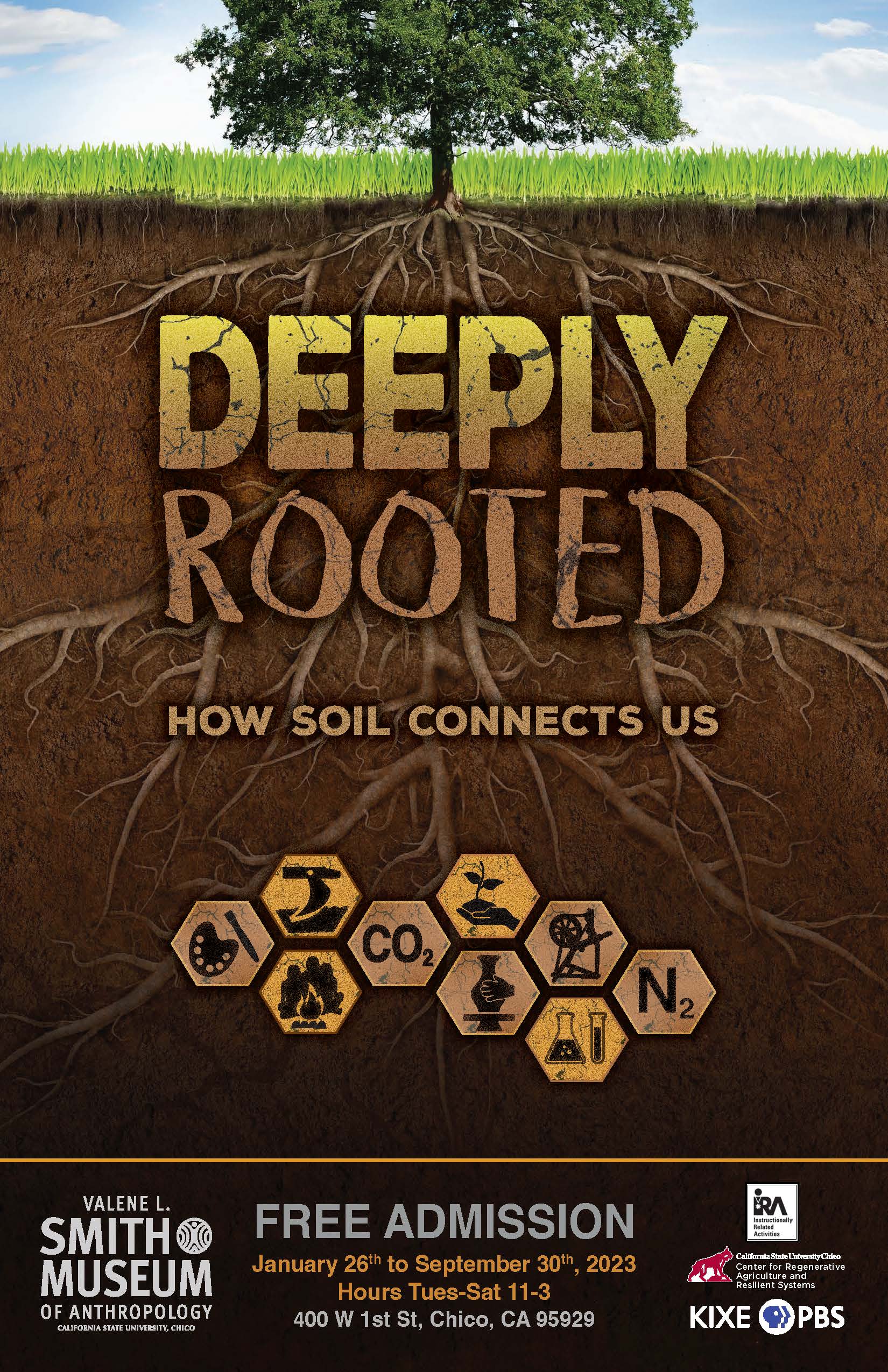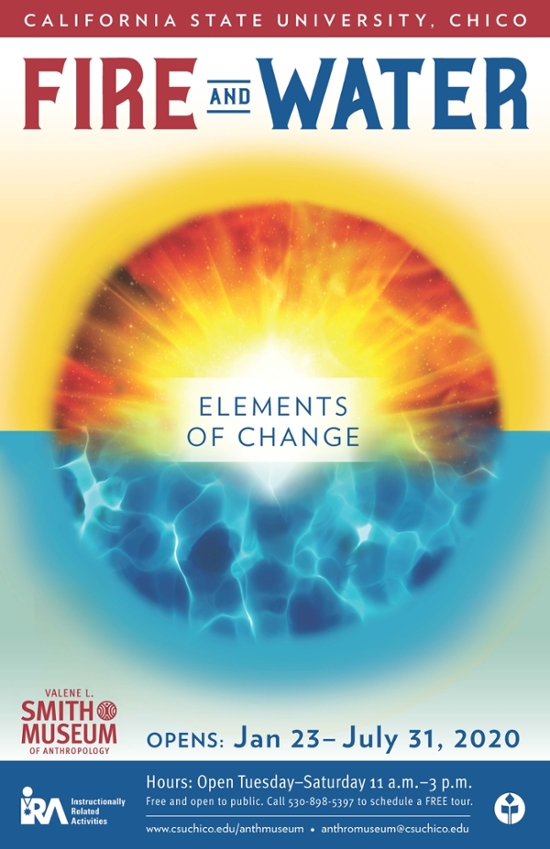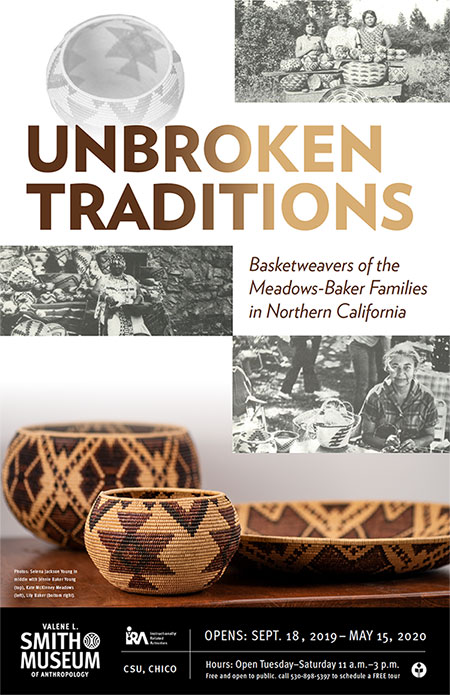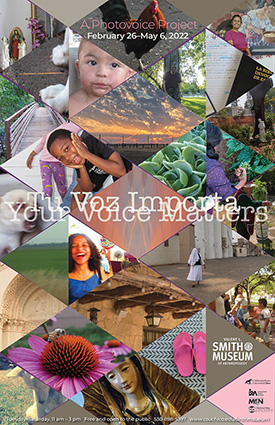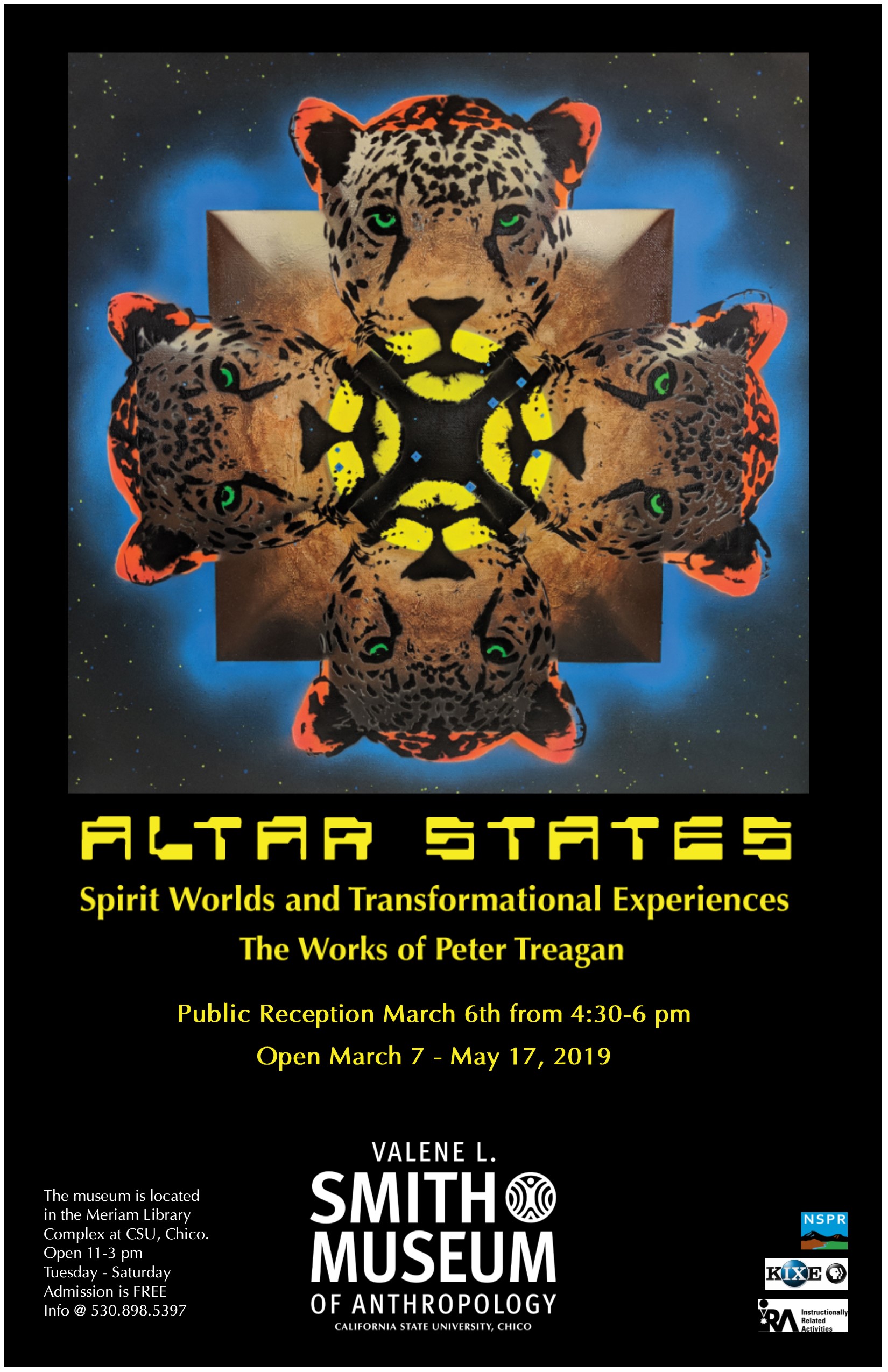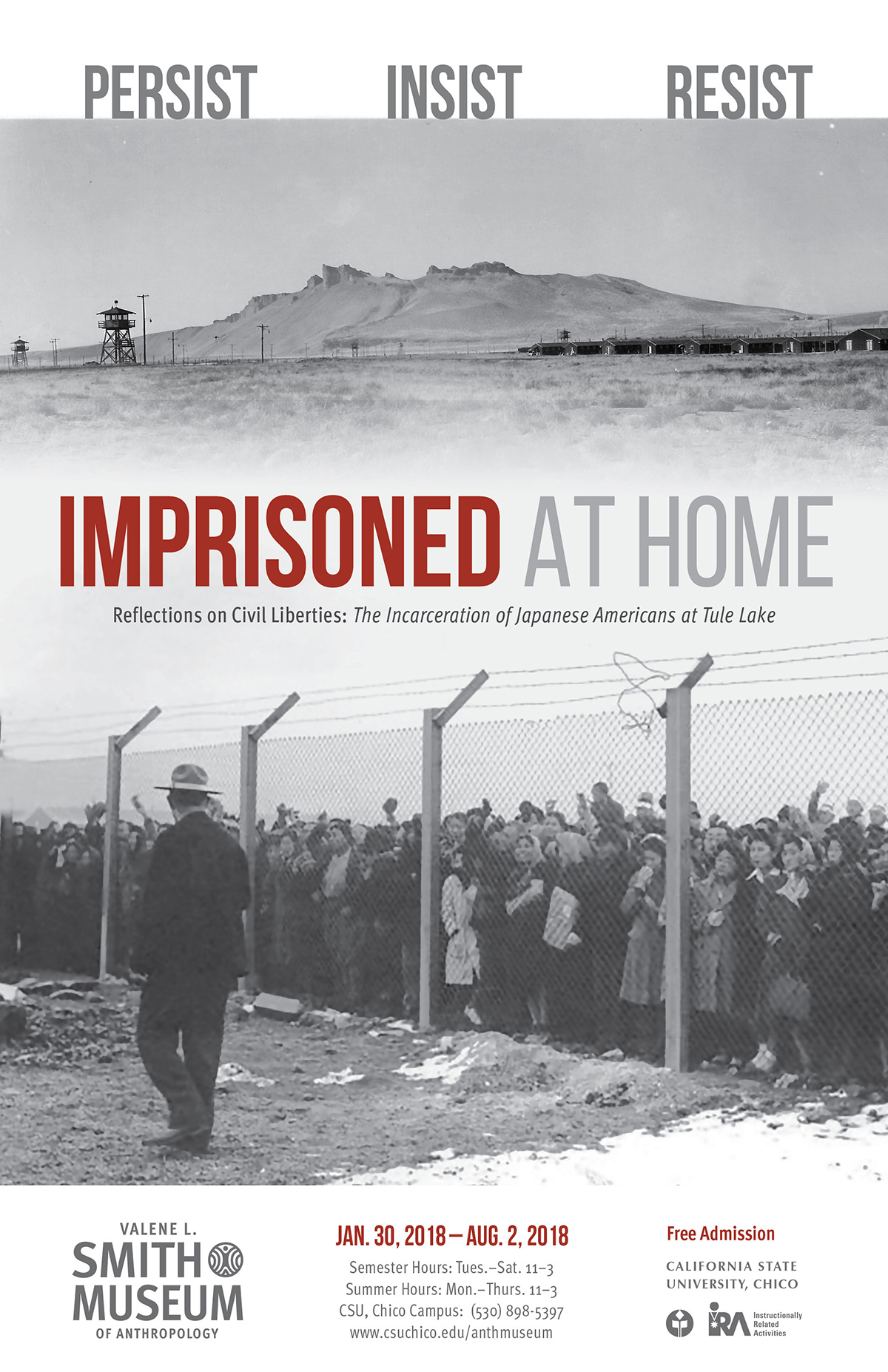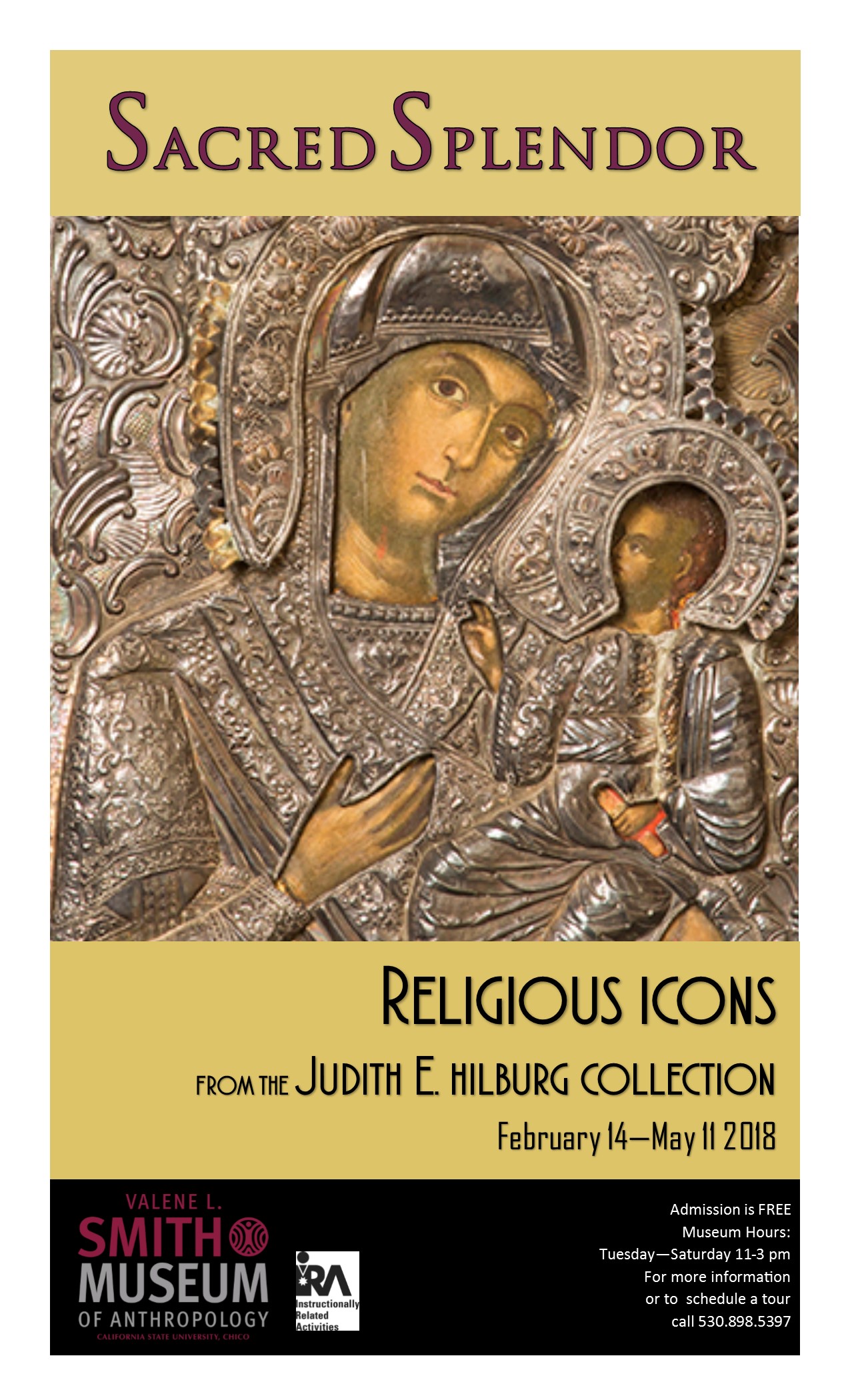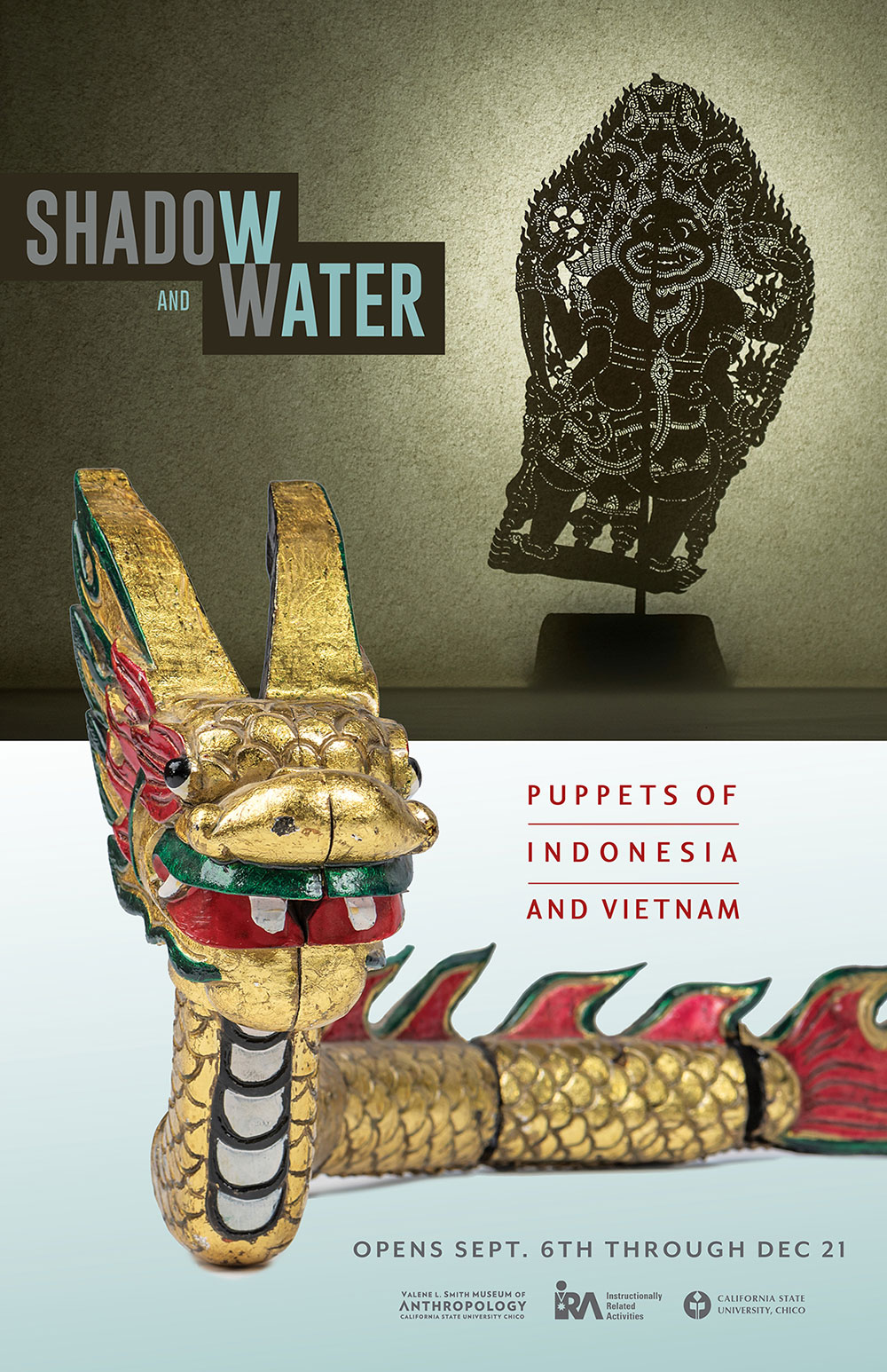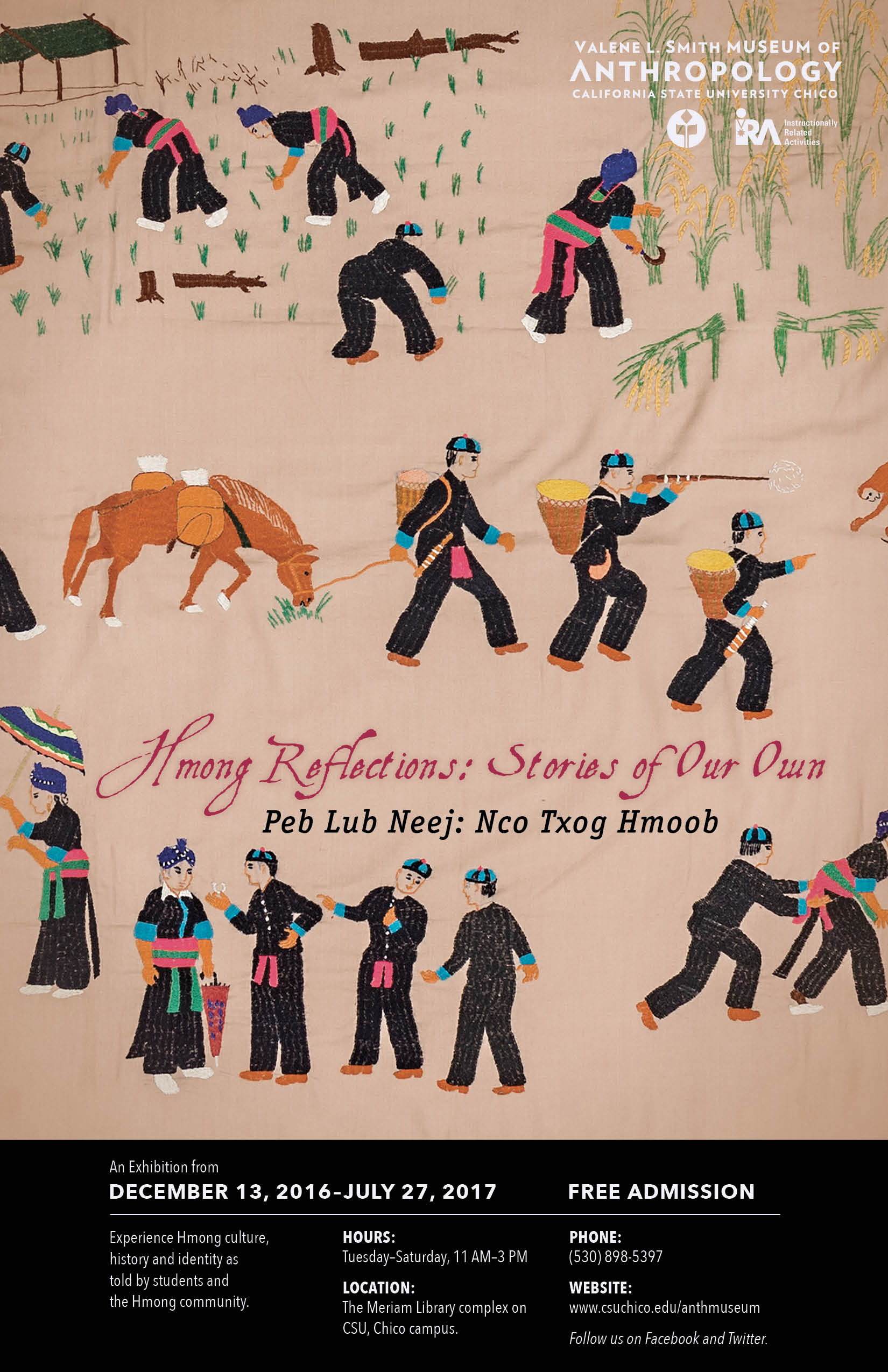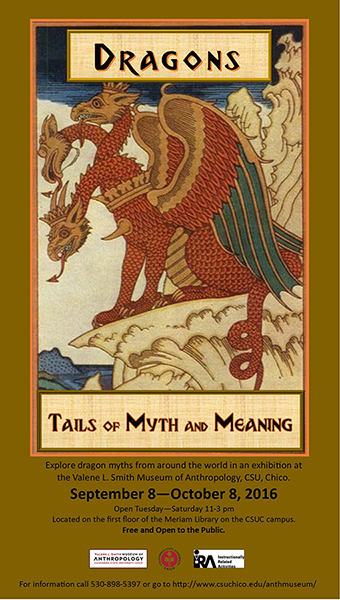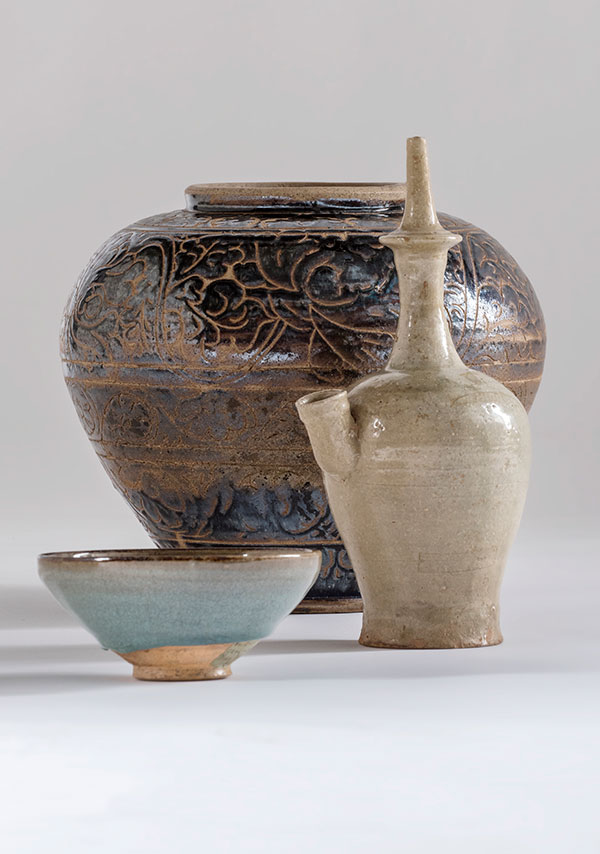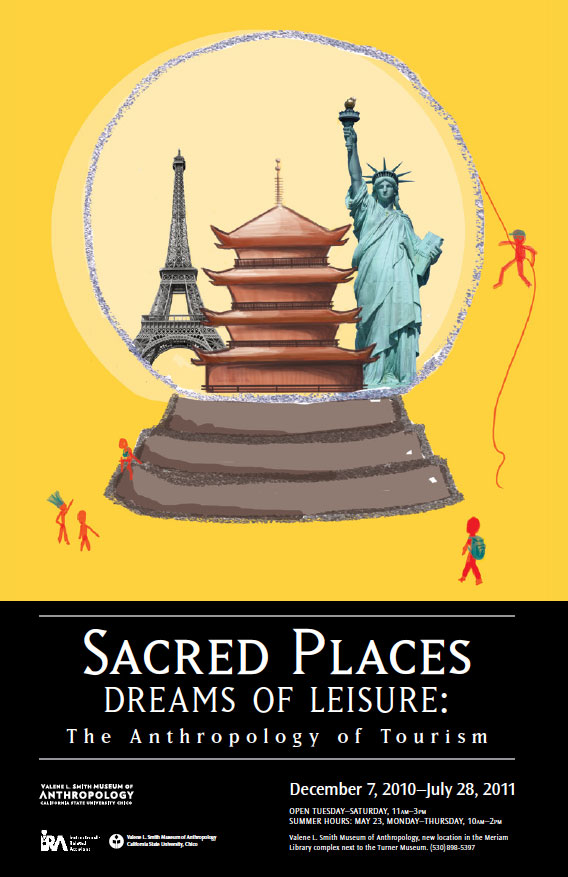- Jump to Exhibit
- Deepley Rooted: How Soil Connects Us
- Delta Sigma Theta Sorority
- Fire and Water: Elements of Change
- Unbroken Traditions
- Tu Voz Importa: Your Voice Matters
- Remarkable Lives: The Interwined Worlds of Birds and Humans
- Altar States - Spirit Worlds and Transformational Experiences
- Reimagining Chico: The Archaeology of Our Neighborhoods
- Imprisoned at Home - Reflections on Civil Liberties: The Incarceration of Japanese Americans at Tule Lake
- Sacred Splendor: Religious Icons from the Judith E. Hilburg Collection
- Shadow and Water: Puppets of Indonesia and Vietnam
- Hmong Reflections: Stories of Our Own
- Dragons: Tails of Myth and Meaning
- Fired Earth: Beauty and Tradition in Asian Ceramics
- From Chico to China: The Life and Travels of Valene Smith
- Leaping Lemurs & Mysterious Crimes
- Material Culture: Wearing the Art of Chikoko
- Into the Blue: Maritime Navigation and the Archaeology of Shipwrecks
- Dreaming Cultures: Myths and Visions of Distant Lands
- Geographies of the Imagination
- Infinity and Beyond: Humanity's Quest to Explore Space
- Ethnomusicology: Exploring the Melodies of Culture
- Coming Home: Ishi's Long Journey
- Cradleboards: Carrying on the Traditions
- Sacred Places, Dreams of Leisure: The Anthropology of Tourism
- Living on Top of the World: Arctic Adaptation, Survival and Stewardship
- Flash of the Spirit!: The Music of Africa and Beyond
- From Cave Art to E-mail: Language and Meaning in Human Cultures
- Maidu Sense of Place: Landscapes of Shared History, Culture and Destiny
- Gifts from the Earth: Ethnobotany - An Exploration of People and Plant Relations
Past Gallery Exhibits
Deeply Rooted: How Soil Connects Us
Chico, CA—What connects us to each other, to nature, to life itself? The hidden world under our feet: soil. The Valene L. Smith Museum of Anthropology at Chico State is offering a new student-curated exhibition, Deeply Rooted: How Soil Connects Us, to open on January 26th, 2023. Under the instruction of museum director, Dr. William Nitzky, and in partnership with soil scientist, Dr. Garrett Liles, Exhibition Design students present the incredible universe of soil and the vital role it plays across global ecosystems and cultures. The exhibition brings together aspects of science and cultural history with special attention given to regenerative agriculture as a path to support soil and human health. Visitors come away with deeper appreciation and insight into our relationship with soil.
Deeply Rooted: How Soil Connects Us offers the North State an immersive, interactive, and educational experience that illustrates how soils connect diverse aspects of the natural world and human experience. Visitors will marvel at the subterranean tunnel that welcomes them into the secret world below us. They will learn how soil has been a vital resource for not only food production, but also a medium for art, home construction, medicine, and cultural identity. The exhibit also recognizes the Mechoopda upon whose homeland Chico State resides. The tribe’s enduring presence continues and is on display in this exhibition with stories and art by current tribal members. Central to the exhibition is also a soil horizon interactive table of Butte County and Lassen Park, offering insight into the ways rainfall and volcanic activity have shaped our region. Sustainability is the lens through which most of the exhibit displays approach the topic of soil. Highlighting how sand and soil are threatened, the exhibit explores alternatives for a more sustainable future for the planet.
Since its inception in 1970, the Valene L. Smith Museum of Anthropology has served as a multifaceted educational facility. The Museum is deeply committed to outreach programming involving community collaboration and civic engagement. The museum’s diversity of outreach programs, include: K-12 school tours, the World Explorations lectures series, cultural and community events. To reserve a school tour or find out more about the calendar of programs this spring please contact the museum. The Museum is open Tuesday- Saturday 11-3 and is free of charge.
Email anthromuseum@csuchico.edu or call 530.898.5397 for more information.
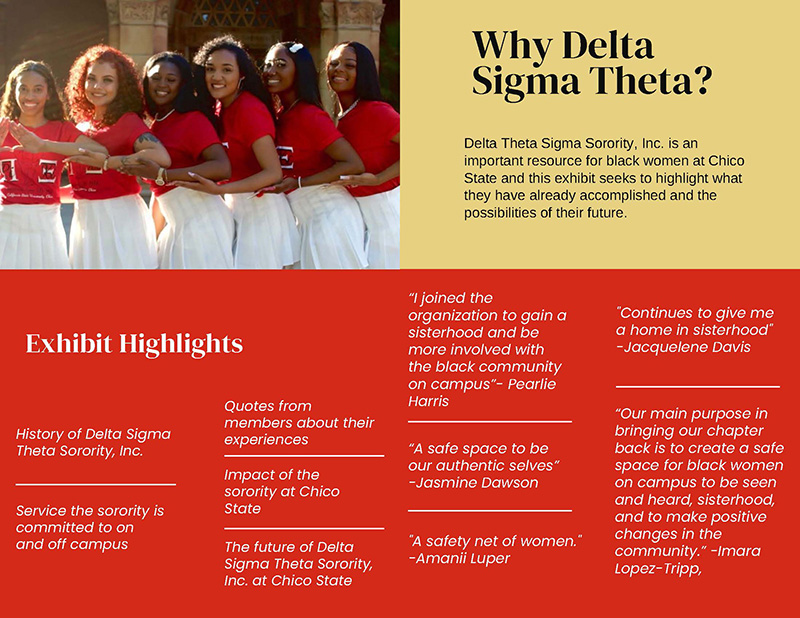
Delta Sigma Theta Sorority
In conjunction with Chico State’s Alumni / Family Weekend, the Valene Smith Museum of Anthropology will launch its first pop-up style exhibition in its newly renovated lobby gallery space. The inaugural pop-up tells the story of the Delta Sigma Theta sorority’s historic return to campus.
The museum is honored to tell this story and spread the word of one of the vital campus organizations dedicated to enhancing Black student life.
Fire and Water: Elements of Change
Students in the Museum Studies Program at Chico State have mounted an exhibition that examines the planetary consequences brought on by the climate crises around the world and close to home. Fire and Water: Elements of Change confronts the extreme disasters of wildfires, rising seas, epic storms and devastating droughts that dominate our news cycle. These events are not just in remote or far off places; rather they have impacted our local communities in ways that have permanently changed our geography and identity. This is personal.
This exhibit observes our changing planet, from an anthropological perspective, through two major elements: fire and water. Ancient and contemporary societies around the world identify four basic elements— fire, water, air, and earth—as a way to understand phenomena in nature. On the surface fire and water appear as opposite forces, but science and traditional ecological knowledge provide frameworks to see the interconnected relationship between these elements.
Both fire and water are life-giving, but can also be forces of destruction and change. Our county has seen and felt these forces first-hand in two crises in two years. On a soggy day in February of 2017, the Oroville Dam’s main and subsidiary spillways could no longer handle the excessive pressure resulting from heavy rains. The threat of the dam bursting prompted the evacuation of more than 180,000 people living in the path of the dam. On a hotter and drier than usual day in November 2018, a spark lit a tree in Pulga and burned through homes and businesses, leaving people homeless overnight. Over the course of the next weeks, the unthinkable became reality. The town of Paradise and other foothill communities had been destroyed by the Camp Fire. Both incidents have taught us that everything must be re-evaluated. Knowledge on all these issues will help visitors be better informed to make tough decisions moving forward.
The exhibition sensitively portrays and discusses these issues and tragic events in a respectful manner. Open spaces, gentle music, videos, and artwork offer a safe space and buffers to explore potentially difficult topics for the community. Global incidents of similar ecological disasters coupled with scientific research connect our local stories with wider dialogues about climate change, water insecurity, plastic waste, and California water issues. Situating local stories with global perspectives offer ideas on actions to take. The exhibit will also feature an interactive Virtual Reality for visitors to experience the Myth of Prometheus in 3-D. The exhibit also features two installations by local artist, Eve Werner.
Humans can be remarkably resilient. In the exhibit, art and the elements converge. Like ourancestors, we see beauty and mystery in nature. From the floods and ashes, we rise with new purpose and creative thoughts to solve and confront climate challenges. We invite the publicto explore the exhibit with a sense of inspiration. The exhibit will remind viewers of the incredible beauty and wonder nature provides. At the same time, visitors will be challenged to connect and engage with the consequences and possibilities the twin forces of fire and water have brought to everyone’s doorstep.
As with all the museum exhibitions, free tours for K-12 and college classes are available. Spring 2020 the Valene Smith Museum of Anthropology will partner with the Turner Museum and Meriam Library to offer a new 3-hour Friday morning program. The three campus entities will provide hands-on STEAM activities to enhance awareness on climate ecological literacy, primary document research and the arts.
Unbroken Traditions
The first viewing of Unbroken Traditions is during the Exhibition Reception on Sept. 18th from 5:30 to 7 p.m.
“When you weave a design into a basket, you put the spirit of what you are weaving right into the basket” – Lilly Baker, Mountain Maidu Basketweaver, 1911-2006
New Exhibition Features Baskets from Four Generations of Mountain Maidu Weavers of the Meadows-Baker Family
The Valene L. Smith Museum of Anthropology will hold a grand opening reception for the exhibition, Unbroken Traditions: Basketweavers of the Meadows-Baker Family of Northern California, on Wednesday, September 18th from 5:30-7:00 p.m. Special guest speakers begin at 6:00 p.m. The exhibition represents the culmination of one year of research and collaboration between Mountain Maidu weavers, other tribal experts, museums studies students, faculty and curators.
The Meadows-Baker family consists of four generations of Mountain Maidu basketweavers who continued the tradition of basketry by sharing their talents. The exhibit shows only a glimpse into the lives of the Meadows-Baker family, but their impact on the cultural and artistic Maidu traditions is monumental.
Visitors will be able to explore the world of basketry and learn about the techniques and materials used to create these practical and ceremonial works of art. The displays feature many uses for baskets such as storage, winnowing, cooking, fishing, acorn processing, and carrying infants.
The exhibition title, Unbroken Tradition, seeks to remind the public of the long unbroken lineage of people who have emerged from repeated attempts to eradicate their culture with their deeply-rooted heritage and traditions intact.
Weavers and the landscape live and work in harmony. The exhibit exposes visitors to the importance of this vital and important reciprocal relationship between the two. Traditional Ecological Knowledge in this context teaches a weaver to learn the proper way to gather weaving materials from the landscape before being allowed to make a basket. The knowledge of the environment, plant lifecycles, and their unique characteristics was passed down through the maternal lineages of the Meadows-Baker family in this way.
As museums across the nation begin to recognize the injustices of the past against Native American groups and as Chico State publically recognizes the land on which it sits as having been the original land of the Mechoopda Tribe, the museum has worked in partnership with the campus Tribal Liaison, Rachel McBride-Praetorius and local consultants to lift up the voices and experiences of Indigenous California Peoples. The basket, in fact, is the perfect symbol of the resilience of a people who survived and now thrive, even when political forces and colonial attitudes tried to eliminate these century’s old ways of life and art forms. We invite you to celebrate the natural beauty and artistry of Maidu basketweavers. These baskets represent a deep and complex understanding and interdependent relationship with the environment as well as remarkable skill and artistry unsurpassed by any other artistic tradition.
Tu Voz Importa: Your Voice Matters
The Valene L. Smith Museum of Anthropology will open a new photography exhibition, Tu Voz Importa: Your Voice Matters during Explore Butte County’s Museum Weekend event on February 26th and 27th from 10-4 pm. The Tu Voz Importa photo-voice project was designed to amplify the unique voices of youth and women by harnessing their abilities to tell their own stories through guided photography and storytelling workshops. Images reflect the insights, families, and worldviews of 13 photographers in the North State region. The show will run through Friday, May 6, 2022. The opening will include a special panel discussion @1pm on Saturday.
The photo-voice process included a series of workshops where participants learned photography and storytelling skills so that they could tell their stories and advocate for change within their communities. Participation in photo-voice projects can be transformative for the photographers, because they build the necessary confidence and skills to be able to effectively tell their story from their own point of view.
The project took place during the pandemic, which offered unexpected hurdles to in-person gathering and learning for both organizers and photographers. “Being able to shift and flex during these times provided its own lessons in resilience,” said Adrienne Scott, museum curator. “The resulting exhibition is a wonderful celebration of the ordinary miracles of life,” she added.
The show brings together a dynamic collaborative team funded by the California Humanities Foundation and the Chico State Instructionally Related Activities Program. The Migrant Clinician Network (MCN), Bay Area photographer, Robyne Hayes, the Department of Anthropology’s museum studies program at Chico State, and 13 photographers have brought their talents forward to tell these stories. Other local community groups, including Promotoras, a community health outreach of Northern Valley Catholic Social Services, Butte County Office of Education and Migrant Education were community liaisons, providing critical project support.
MCN has a long history of working with photography as an art form to create and sustain venues that address social justice. Hayes, the director of Tu Voz Importa, says that photo stories have the ability to express issues that are going unaddressed in underserved communities. “Photographs can bring empathy and understanding that words couldn’t do,” she noted. Hayes has over eight years of experience using documentary photography, as a tool to empower people. The Museum and Museum Studies students welcomed this partnership and opportunity to lift up the art and voices of those in our community not typically displayed in museums.
The exhibit opening and panel discussion are part of Explore Butte County’s Museum Weekend event. The museum will be open both Saturday and Sunday Feb 26 and 27 from 10am to 4pm. Free Admission. The museum is free and open to the public Tuesday- Saturdays 11-3.
Remarkable Lives: The Intertwined Worlds of Birds and Humans
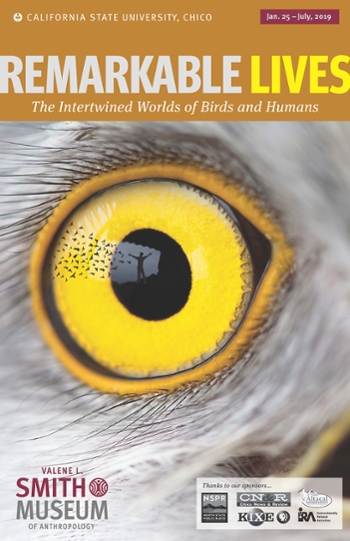
Bird songs and behaviors have resonated with peoples of every time and place. Their natural beauty inspire great art, dance, ritual and fashion on every continent. Local photographers capture these living dinosaurs still among us and a robotic recreation of the late Jurassic Archaeopteryx gives new meaning to the phrase early bird.
Additionally, the exhibition reveals both the damage to global ecosystems and the consequences for birds worldwide. The innovations of citizen science, agricultural flyways and backyard habitats mitigate these influences and create lush, fun, mini ecosystems that really support local and regional bird life. Visitors will consider the impact humans are having on the lives of birds, and how the metaphor of the proverbial canary in the coal mine is playing out on the world stage. The museum is delighted to be partnering with the Altacal Audubon Society and Snow Goose Festival. In its 20th year, the Snow Goose Festival strives to increase public awareness and conservation of wildlife and habitats of the Northern Sacramento Valley.
The museum will add an extra open day on Sunday, January 27th from 11-3 to accommodate the Snow Goose Festival, which runs January 23-27. Birds and Birders, alike, flock to Chico, which is ideally situated near the Pacific Flyway, a major migratory hub for many bird species during the winter.
Photo Gallery - Remarkable Lives
Explore the sights the Remarkable Lives exhibit.
Altar States - Spirit Worlds and Transformational Experiences
The Works of Peter Treagan
Public Reception March 6th from 4:30-6pm
Open March 7 - May 17, 2019
Transformational Festivals have emerged across the globe in part as a response to the unprecedented societal and ecological challenges facing the planet. Altar States offers a glimpse into artist Peter Treagan’s ethnographic field research at Transformational Festivals in North, Central, and South America. The artwork on display served as the basis for a Master’s Degree Project at CSU, Chico in Social Science.
Peter Treagan’s interactive tech art immerses you into alternative worldviews and paradigms present in this global movement. By dimming the lights and wearing 3-D glasses – visitors become participants in a transformational visionary art experience – where they gain access to once hidden imagery revealed only through UV black lights. The artwork confronts the liminal spaces where consciousness can shift from one plane to another and seeks to make visible the individual and collective transformational experiences achieved through ritual, ceremony and prophetic experiences present at transformation festivals.
Peter’s research takes him across the Americas, meeting up with festival organizers and attendees in search of a global ecological philosophy to guide and shape the dialog for positive change. Come discover the inner landscapes and otherworldly vistas curated and created by Peter Treagan in Altar States.
Reimagining Chico: The Archaeology of Our Neighborhoods
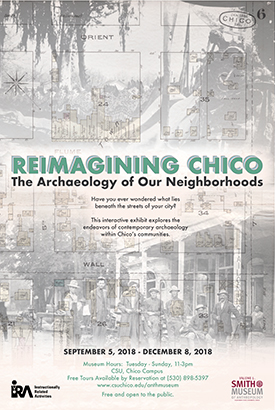
Have you ever wondered what lies beneath the streets of your city? This interactive exhibit explores the endeavors of contemporary archaeology within Chico's communities.
In an exhibition that explores Chico neighborhoods through the artifacts found on archaeological digs, visitors are invited into a world almost unrecognizable today.
Two separate excavations in Chico have yielded historical artifacts that shed light on daily life more than a Century ago. One excavation took place on the Chico State Campus and yielded historic artifacts from boarding houses dating to the early 1900s. The other excavation will connect visitors with the long abandoned historic Chinatown of Chico.
Visitors can turn their eye towards the present and learn about Chico’s South Campus Neighborhood Project - the award-winning neighborhood improvement planning effort coordinated by the Resilient Cities Initiative at California State University, Chico and the Public Works-Engineering Division at the City of Chico. Learn how modern anthropological methods captured the perspectives of residents in Chico’s most historic, diversely-used, and dense neighborhood.
Explore Chico’s past and present through interactive archeological activities and maps. See Chico through the eyes of anthropology in this educational exploration of our community.
Imprisoned at Home - Reflections on Civil Liberties: The Incarceration of Japanese Americans at Tule Lake
Visitors followed the journey of several individuals and their families who were held behind barbed wire at the maximum security Tule Lake Segregation Center that housed more than 18,000 people of Japanese ancestry during the war. Students in the museum studies program at CSU, Chico, in collaboration with members of the Japanese American community, erected a replica barrack unit of the Tule Lake center. On display are interactive audio/visual installations and artifacts of daily life in the camp, such as identification pins, personal censored letters, hand-made playing cards, artwork, shell ornaments, wooden toys, and newspapers - all made by incarcerees in an effort to normalize their disrupted lives.
A documentary film about local resident Jim Tanimoto, 94 years old, is also featured in the exhibit. He tells his story so that the younger generation of Americans might continue to protect their civil rights. The exhibit ends with an art table to process the powerful messages contained in the exhibit.
The Grand Opening of Imprisoned at Home coincided with California’s Fred Korematsu Day, which commemorates the life and activism of a national civil rights advocate. Imprisoned during WWII, Mr. Korematsu spoke up about injustice and racism against the American citizens of Japanese descent who were forcibly imprisoned. In 1983 the US District Court overturned his conviction and in 1998 he was awarded the Medal of Freedom by the White House. In 2010 the California legislature declared Jan 30, Fred Korematsu Day.
The exhibit features a quilt that was thrown over the barbed-wire fence by a stranger into the arms of a Shizuko Ina, who was pregnant.
Learn more about this powerful story at the 50 Objects/Stories The American Japanese INCARCERATION
Read the story of "Shizuko's Quaker Quilt" at the 50objects.org(opens in new window).
The exhibition gives voice to significant questions that continue to have meaning in our democracy: Who is a citizen? Are human rights universal? When can one dissent and is it a constitutional right? What can we learn from
The museum held a 5-part speaker series in conjunction with the Imprisoned at Home exhibit this spring.
Sacred Splendor: Religious Icons from the Judith E. Hilburg Collection
The opening reception is to be held on Wednesday, February 14, from 4:30 – 6:00 pm, and the exhibit will run until May 11, 2018. Located on the CSU, Chico campus, the museum is open to the public Tuesday – Saturday 11:00 to 3:00 and is free of charge.
Sacred Splendor offers a glimpse into the expansive and rich collections of Judith E. Hilburg, an avid collector of all things art, culture, and natural history. Mrs. Hilburg’s collections are the summation of over 50 years’ worth of collecting. Her fascination with sacred objects has resulted in a diverse collection of Christian icons that span both time and space. Judith E. Hilburg is survived by her two daughters, Linda Barker and Lore Hilburg, who have generously loaned the icons for display.
The 16 pieces selected for this exhibition chronicle a history of art, devotion and the influence of colonization on the sacred imagery. The blending of two or more religious traditions, known as syncretism, is demonstrated through Christian motifs combined with diverse cultural symbols – showing the faith’s movement across the globe. Visitors will encounter a range of Christian icons - including an Albrecht Durer print, Indo-Portuguese carvings, paintings from the Cuzco Schools (Escuela Cuzqueña) of Peru, a William Morris cartoon, Russian traveling icons, and a textile from Paracas dated to 100-300 BCE.
Shadow and Water: Puppets of Indonesia and Vietnam
Enter into a world where the stories of the human experience are brought to life through shadow and water, leather and wood, music and narrative. Learn about and see a collection of Wayang Kulit and Wayang Golek - shadow puppets of Indonesia and Mua roi nuoc - water puppets of Vietnam. The collection is on loan to the museum from Rick and Nancy Ostrom, who spent several years living and working in Indonesia.
In the Wayang traditions, shadows are cast upon cloth, with only one dalang, or puppeteer, narrating a story that can lead into the night and include up to 100 puppets. The tradition, which dates back to 900 CE, was designated a Masterpiece of the Oral and Intangible Heritage of Humanity by UNESCO in 2003.
Mua roi nuoc, which translates to, “making puppets dance on water,” in Vietnamese, dates back to the 11 thcentury. The tradition grew from a place were flooded rice fields offered villagers a place to entertain each other with stories of daily life and folktales - using water as the stage. The shows, which are still performed today, are done in waist deep water, with the puppeteers hidden behind a screen. The puppets are maneuvered using long bamboo rods that remain underwater and out of sight.
Hmong Reflections: Stories of Our Own
We all want to know where we came from and where we are going; to reflect on our history and consider our future. With this in mind, the latest exhibit is a community collaboration between the Chico State museum studies program, The Oroville Hmong Cultural Center, the Hmong Student Association, and many other individuals to tell the story of the Hmong in Butte County.
The story of the Hmong is one of survival and transition; it is a search for freedom. Hmong culture, history, and identity is shaped by a myriad of hardships and triumphs experienced in Laos and Southeast Asia as well as the United States.
Through the narratives of multiple generations of Hmong Americans, told from their own perspectives, this exhibition explores the changing lives of the Hmong people. The stories found here are of strength, courage, determination, dignity, and community. They are reflections of the Hmong – thinking back and looking forward.
Dragons: Tails of Myth and Meaning
September 8 - October 8 th 2016
Dragons lurk in the collective imaginations of many cultures throughout the world. Some dragon stories embody the most terrible and horrifying aspects of humanity, while others represent the highest ideals of society. We invite you to discover and explore the dragons of the world. Peak into a dragons cave, touch a dragon’s claw, and see a Chinese Imperial Dragon robe in an interactive exhibit for dragon lovers of all ages.
Fired Earth: Beauty and Tradition in Asian Ceramics
January 27- July 2016
Fired Earth featured the University’s Behrick pottery collection. The collection encompasses 120 pieces, featuring a variety of rare pieces from China, Korea, and Japan. The exhibition spanned 2,000 years of creativity and ingenuity, when making the world’s finest porcelain was a carefully guarded Chinese secret. Some of the most notable pieces were from the Ming Dynasty (1350-1600). Each piece of pottery illustrates a fragment of historical and cultural fluidity ebbing and flowing from lavish emperors, ceramic production advancements, opportunistic global trade, and changing political landscapes.
In addition to the pottery, kimonos from Matsumi Toku’s personal collection and the tools required for calligraphy from Robert Benner’s collection were also featured in the exhibit. Visitors explored the meaning and symbolism behind the Japanese tea ceremony and unfold the intricate process of putting on a kimono. Guests discovered the “four treasures” associate with the 3,000 year old art of calligraphy. The connection between Asian art forms is revealed, and one senses the vitality which is deeply entwined in a very long history of creativity, innovation and inspiration.
The exhibition fused the traditional art museum experience with the historical critical context of an anthropological museum, creating a brilliant feast for the eyes and mind of the visitor.
From Chico to China: The Life and Travels of Valene Smith
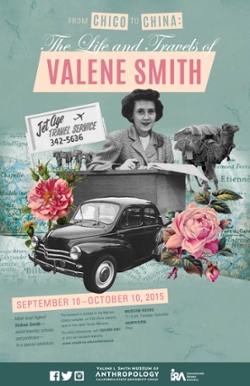
Springing forth from the depression era, a period of American history in which women’s careers were typically limited to the home, hospital, or school house, anthropologist Valene Smith was navigating the globe via plane, train, boat, and car.
From the caves of France to the bazaars of India, this former Chico State professor was not only exploring the world but also charting out the unknown territories of Tourism Anthropology. In our new exhibit, the amazing story of this local travel and tourism pioneer will be brought to life through photos, videos, and an array of her own worldly artifacts.
Learn about the remarkable life of Valene Smith this fall at our annual student-curated exhibit and spark your wanderlust.
Leaping Lemurs & Mysterious Crimes
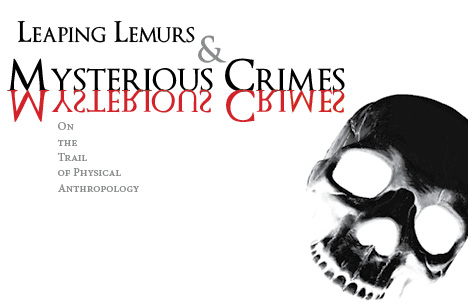
Leaping Lemurs and Mysterious Crimes (December 2014-July 2015) explored the human journey from our African roots to modern humans through the eyes of physical anthropology. From ancient fossil remains and changes seen in the human skeleton over millennia, plus recent developments in DNA research, and the evolutionary developments in human and on-human primates, the painstaking work of anthropologists comes to life, helping us better understand our human past. That’s not all. Do you like the television shows CSI or Bones? See how forensic anthropologists really work as our exhibit showcases a mock crime scene investigation, all part of the life of physical anthropologists working in the 21st century.
Material Culture: Wearing the Art of Chikoko
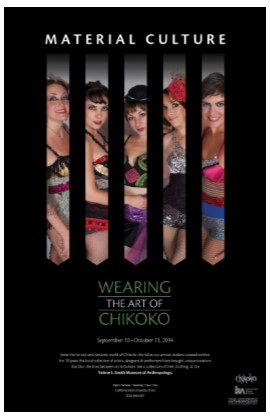
September - October 2014
Enter the far-out and fantastic world of Chikoko at our annual student-curated exhibit. For ten years this local collective of artists, designers, and performers have shared unique creations that blur the lines between art and fashion within our community.
See a collection of their clothing that ranges from political to playful at the Valene L. Smith Museum of Anthropology Museum.
Into the Blue: Maritime Navigation and the Archaeology of Shipwrecks
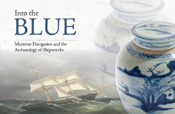
The museum dove into the underwater world of shipwreck archaeology and nautical secrets of the Frolic, a ship which sank off the Coast of Mendocino during the Goldrush in 1850 in, Into the Blue: Maritime Navigation and the Archaeology of Shipwrecks. The exhibit featured authentic artifacts recovered from the Frolic on loan from the Mendocino County Museum. Artifacts from Bob Benner's world-class collection of historical navigation instruments were also on display. These included an astrolabe, a Polynesian navigation chart, a ship's chronometer and a sextant. Seafaring explorers of all ages will enjoyed this dynamic and interactive exhibit.
The exhibition was open to the public December 2013 - July 2014
Dreaming Cultures: Myths and Visions of Distant Lands
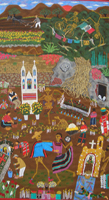
Enter into a world where stories, myths, and symbols of diverse cultures are rendered in the art of self-taught artist, Lida Penkova.
Born in Czechoslovakia, Lida Penkova spent her life traversing the globe. When she retired from a career as a psychotherapist, she decided to give form to the traditional stories that captivated her throughout her life’s journeys.
Mythical and mundane characters are brought to life in paintings and linocuts that explore a wide range of themes - from the Mexican Days of the Dead to the Australian Aboriginal Dreamtime.
Geographies of the Imagination
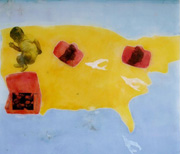
August 2013 - September 2013
What is home? A physical place on a map or a place that resides in our imagination? Cultural Anthropologist and professional artist Lydia Nakashima Degarrod, born in Chile, interviewed Chilean exiles about their experience of leaving their homeland to escape the intolerable circumstances of Augusto Pinochet's dictatorship. Through collaboration and intimate communication, Lydia created images, maps, and video to powerfully depict their individual journeys.
Infinity and Beyond: Humanity's Quest to Explore Space
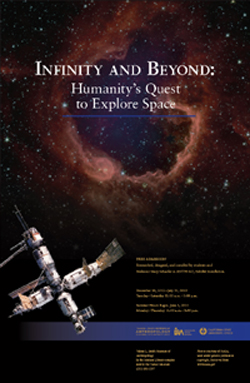
To be able to rise from the earth; to be able, from a station in outer space, to see the relationship of the planet earth to other planets; to be able to contemplate the billions of factors in precise and beautiful combination that make human existence possible; to be able to dwell on an encounter of the human brain and spirit with the universe-all this enlarges the human horizon…
- Norman Cousin, World Peace Advocate
From earliest times humans have looked to the skies with a sense of awe at the vastness of the universe that envelops us. Humans have soared to the other side of the sky to explore beyond the frontiers of our planetary orbit and become acquainted with the greater whole of the solar system we are a part of.
The exhibit, “Infinity and Beyond: Humanity’s Quest to Explore Space” presents the opportunity for you to venture into space, to visualize the breathtaking beauty of our galaxy and beyond, and to learn and wonder about humanity’s place in space. Drawing from scientific discoveries about space, our understanding of anthropology, our sensibilities of design, and the power of the imagination we present our interpretation of the all encompassing magnitude that space has on humanity’s past, present and future existence. Come join the quest to explore space from infinity to beyond.
Ethnomusicology: Exploring the Melodies of Culture
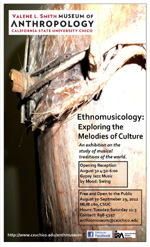
August 2012 - September 2012
Music reflects the cultures of the world - expressing the magnificent variety of human emotions and experiences. From a banjo player in the Appallacian Mountains to a fiddle played by Huichol Indians of Mexico, music tells the story of a people, a time, and a place.
In this exhibit, visitors took a musical journey through the anthropological lens, viewing instruments from around the world and learning about the ways in which identity, religion and folklore are woven into the fabric of the musical of traditions of the world.
Coming Home: Ishi's Long Journey

December 2011 - July 26, 2012
A hundred years ago, on August 29, 1911, Ishi, the last living member of a small band of Yahi Indians, chose to walk into the Euro-American society of the early 20 th Century. As the centennial of Ishi’s arrival in Oroville closes in December, the Valene L. Smith Museum of Anthropology will open an exhibition to reflect on aspects of Ishi’s story. The exhibit will run through July 26, 2012.
The exhibition traces his many encounters, transformations and adaptations to the modern world. From the beginning of his journey with a short stay in the Oroville jail to entering Victorian society in San Francisco, Ishi became a part of a new chapter in Native American history. With Professor Alfred Kroeber in the anthropology department of the University of California, Berkeley, Ishi provided many first-hand insights into a bygone lifeway and became a living exhibit on Native American culture for the university museum. His cooperation with preserving the lifeways of the Yahi people in the face of personal tragedy and the devastating reality of the annihilation of his tribe and American Indian populations, in general, has left us with insight, information, and material culture that help better explain the cultural practices of California Indians.
The memory of Ishi and his long journey are preserved into the future as many Native Americans and others continue to honor his life. His legacy lives on in the collective memories of other California Indian tribal groups who are still here.
The exhibit ends with a display titled the Ishi Digital Memory Project, allowing many voices to contribute their reflections on the impact Ishi has made on their lives and this area. The museum has provided a web cam interactive to encourage our visitors to reflect on the significance and example of Ishi’s life and its continued meaning for a new generation. The museum staff and students recognize that one exhibition, like one man, cannot represent the entire telling of a complex and still unfolding story. We invite you to join the story…
Cradleboards: Carrying on the Traditions

March 2012 - July 2012
Our exhibition, Cradleboards: Carrying on the Traditions, was created by the Museum Studies Students of ANTH 466 under the leadership of Museum Co-Director, Dr. Stacy Schaefer.
The birth of a baby brings new life into the world. In many Native American cultures these tiny little ones are well cared for within the comforting cradleboards specially made with love and good thoughts for their arrival. Cradleboards protect the physical well-being of the baby and provide a special vantage point with which to view the world.
Many of the cradleboards on display were generously donated to the museum by the family of anthropologist Dorothy Hill. Sandra Knight and the Mechoopda Tribe of Chico Rancheria graciously shared one of their cradleboards and photographs of the fruits of their cradleboard-making activities. Cradleboard-maker extraordinaire, Susan Campbell (Mountain Maidu and Pitt River) kindly provided her assistance and expertise to Dr. Stacy Schaefer’s ANTH 466 class.
Through these wonderful collaborations, students gained valuable skills in exhibit research and design as they learned about the meaning and importance of the vital, long-standing tradition of cradleboards in Native American cultures. We hope you enjoy the exhibit, the beauty and craftsmanship of the cradleboards. The images of babies and their families are bound to make you smile and reflect upon the preciousness of life
Sacred Places, Dreams of Leisure: The Anthropology of Tourism
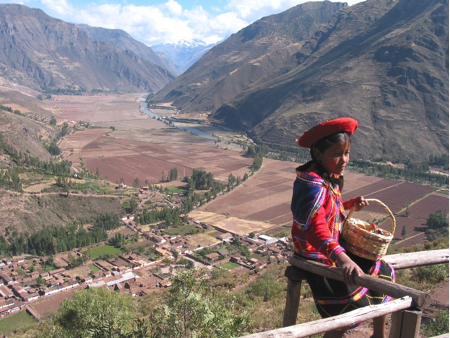
December 7, 2010 to July 28, 2011
Photograph by Sharon Gmelch
As anthropologists, we study human cultures and human behavior through a holistic view and cross-cultural analysis, both the hallmarks of anthropology. This is accomplished through four main approaches: archaeology, the study of past human cultures; biological/physical anthropology, which includes human evolution, and the biological adaptations humans make in their surroundings; language and how humans communicate; and cultural anthropology, the study of contemporary cultures.
Dr. Valene L. Smith, as a cultural anthropologist and geographer, was an early advocate for the study of tourism. In 1964, she proposed this topic for her doctoral dissertation and was denied, because there was no body of literature in the field. In 1974, Dr. Smith and a group of anthropologists met at the annual meeting of the American Anthropological Association (AAA) in Mexico City. This meeting was followed by edited papers that were published in Smith’s seminal book, Hosts and Guest: The Anthropology of Tourism (1977), an anthology of writings from many scholars on their experiences with the economic and social impacts of tourists on cultures around the globe. Dr. Smith and these researchers thus paved the way for the scholarly acceptance of tourism in anthropology.
The study of tourism has blossomed in recent years, resulting in a rich body of published papers, books, and conferences. Some key researchers and scholars include Edward Bruner, Erve Chambers, Eric Cohen, Sharon and George Gmelch, Nelson Graburn, Dean MacCannell, Margaret Swain, and many others. While today, anthropologists still grapple with precise definitions and measures to categorize their research with the field of tourism, it is a respected area of work to undertake.
Defining Tourism
How do we define tourism? There is no perfect definition, but generally, to quote Erve Chambers, it encompasses the study of “any kind of travel activity that includes the self-conscious experience of another place.” The anthropology of tourism, simply put, is the academic study of the relationships between tourists and the people and places they visit.
The study of travel and tourism is nothing new; throughout the millennia, humans have wandered and traveled the globe and shared their observations with others. In his book, The Songlines, the late Bruce Chatwin observes the nomadic nature of humans throughout history. As humans, are we inherently wanderers by nature?
Developments after the Second World War might support Chatwin’s philosophical musings, as tourism quickly became a global phenomenon, and a full-fledged industry. As a result, the study of tourism is now interdisciplinary, multifaceted, and complex. Every day, countless encounters between travelers and their hosts play out world-wide. As anthropologists, we are interested in the cultural processes associated with these human interactions and their meanings, providing us with potentially powerful insights in what it means to be human.
Put on Your Traveling Shoes
Within this exhibition, we invite you to ponder the many topics we explore, such as the influence of media on destination choices, meeting famous explorers, following the religious pilgrim’s journey, or embarking on an all-American road trip. Find out what makes an “authentic” experience abroad, visit controversial sites, see the Seven Wonder of the World, and cruise the Caribbean. Bon Voyage…
Living on Top of the World: Arctic Adaptation, Survival and Stewardship
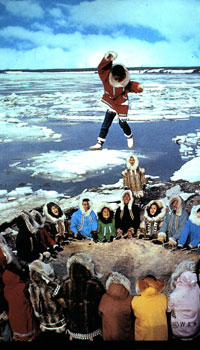
December 10, 2009 - July 26, 2010
The museum’s new exhibit, “Living on Top of the World: Arctic Adaptation, Survival and Stewardship,” invites visitors to see the Arctic like they’ve never seen it before, leading them to discover the wonder of the place, the animals and, above all, the people.
For thousands of years, the top of the world has been the home of Arctic peoples. This is also the homeland for polar bears, caribou, walruses, seals, whales, wolves, fox and many other animals unique to this dynamic region of the Earth. In this exhibition visitors can see some of the ingenious ways that humans have adapted to survive and enjoy life even in such a challenging environment. It may surprise them to learn that the original people to inhabit the Arctic and the array of wildlife found in these northernmost lands may hold the key to our planet’s future and the fate of humankind.
Collaboration is the watchword for the museum this year, as in years past, and the museum has brought together Arctic collections and artifacts from many institutions and private collections. An extensive collection is on loan from the Jensen Arctic Museum at Western Oregon University, several modern Inuit artworks are on loan from the Turner Museum on the CSU, Chico campus, and a rare auklet parka once belonging to Smith and now housed by the Phoebe Hearst Museum in Berkeley is also on display (see below description).
The Arctic exhibit also includes artifacts from the museum’s own collection given by researchers and collectors who donated significant art and artifacts from their Arctic explorations as well as personal pieces from the work life of Smith. These materials combine with the others on loan to weave a cohesive narrative of Arctic life before Western contact and continuing through today.
About the Auk Parka
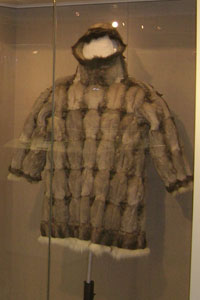
This parka was made for Smith in 1965 by Hilda Aningayou on St. Lawrence Island in the Bering Strait. It is made from the skins and feathers of more than 80 auklets. It took three years to fashion the whole garment; two years to hunt the full amount of birds and one year to prepare and stitch the skins and feathers in the traditional manner.
While Aningayou made the parka, many younger women gathered to watch her methods. This technique had not been witnessed previously by that generation. A few years later, this parka was featured in Smith’s film version of Three Stone Blades. To anyone’s living memory, this was the last time an auk parka was made by someone in the Arctic.
Flash of the Spirit!: The Music of Africa and Beyond

The rhythm of culture comes alive across the African Continent! Spring 2009
The rhythm of culture comes alive across the African continent in this year’s Museum of Anthropology exhibition at CSU, Chico. Music is the shared doorway between understanding the regional similarities and differences in social, political, and religious ways of life in the many countries and regions of Africa. Drumming, dancing, performing, and singing styles find their home within a variety of social contexts and ritual meanings. A wide array of instruments, masks, jewelry, and other cultural artifacts lead the beat toward deepening the visitors’ encounter with these regions. Interactive exhibitions offer direct experiences with the power of the music. From traditional talking drums, to Reggae, to the Afro-Brazilian sounds of Bahia, follow the musical journey across Africa and beyond.
Although Africa encompasses 54 countries with multiple tribal influences in each one, Westerners still have a tendency to see the customs and lifestyles of these many regions in an undifferentiated manner. Part of the goal of this exhibition is to cultivate an appreciation for the many musical and cultural expressions upon this vast landscape and give social meaning and context within its respective communities. As globalization and Western influences come to these communities, what are the changes in the society and the music? Additionally, how have these African musical traditions influenced music and culture beyond their borders?
The exhibit encompasses 13 topics, including Chico’s own Lansana Kouyate, originally from Guinea who teaches the instrument of his homeland, the balafon. Also featured will be local retired teachers Ted and Frieda DeBernardi, who recently donated to the museum a tremendous musical instrument collection from Kenya and Tanzania.
From Cave Art to E-mail: Language and Meaning in Human Cultures
Spring 2008
Anthropologists and linguists agree language has been a part of human culture for at least 40,000 years. The archaeological record explodes with art and artifacts at that time, indicating that more complex speech systems had developed. That was just the beginning. In this exhibition the story of human language is told through the eyes of many cultures and their artwork, geographic location, and social systems.
In the mythology of arctic peoples, the migration of polar bears and whales is explained by the transformation of whales into polar bears. The mask to the left, carved from a large piece of whale vertebrae with polar bear teeth holding the emerging polar bear, depicts this story. The mask is on loan to the museum from the private collection of Dr. Valene Smith Posey, emeritus professor of anthropology at CSU, Chico.
The museum invites visitors to discover the global expressions of language and communication. The arts and sounds of human life point the way toward understanding the origins and challenges facing the 6,912 languages of the world today. Explore the Upper Paleolithic cave art of Europe. Listen to the chanting voice of Ishi recorded 100 years ago on wax cylinders. Read a page from a 14th century illuminated manuscript. Hear an excerpt from Beowulf in Anglo Saxon. Create a poem on a refrigerator door. Experience the intricate Tanzanian wood carvings, whose images leap out of fantastic worlds with unfamiliar stories.
Before leaving the museum, visitors will have a chance to wrestle with some age-old questions. Can great apes use sign language like humans do? Did ancient cultures deface buildings with graffiti? And is it really true that men don’t listen and women can’t read maps?
“There’s something for everyone at this year’s exhibition,” says Adrienne Scott, museum curator. “Whether seeking an understanding of linguistics, an overview of the various writing systems or if you just love art and storytelling From Cave Art to Email offers an appealing outing for a wide audience.”
Maidu Sense of Place: Landscapes of Shared History, Culture and Destiny
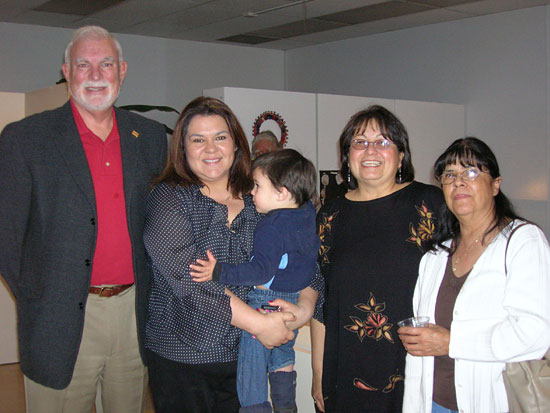
The California State University, Chico Museum of Anthropology and the Mechoopda Indian Tribe collaborated with the Maidu tribal members of the Chico, Susanville and Oroville regions to present the current exhibition: Maidu Sense of Place: Landscapes of a Shared History, Culture and Destiny at California State University, Chico. This exhibit ran through May 25, 2007.
“This exhibit offers the public a unique opportunity to view the inspiring results of a collaborative learning project in which guest curator Arlene Ward and Maidu consultants shared their knowledge in presenting Maidu history and culture from the voices of Maidu people,” said Dr. Stacy Schaefer, co-director of the CSU, Chico Museum of Anthropology.
The exhibit showcases the Maidu’s close relationship to their traditional lands surrounding Chico into the Sierra Nevada foothills and to Mount Lassen, and how Maidu life was impacted after Western settlement.
“The Maidu are a strong people,” said Mechoopda Chairman Dennis Ramirez. “This exhibit attempts to share the Maidu memories and stories from our perspective.”
This display takes visitors on a journey from pre-Western contact to contemporary Maidu life, illustrating that Maidu Tribes still exist and continue to preserve their cultural traditions, history and land.
“This sense of place is not only a locality, it is the people,” said Arlene Ward, guest curator of California State University, Chico Museum of Anthropology. “The villages of this great area were many and only a few remain. It’s important that these stories are not forgotten.”
CSU, Chico exhibit traces Maidu life into the 21st century
Gifts from the Earth: Ethnobotany - An Exploration of People and Plant Relations
As the museum continues to grow and thrive as a cultural resource in the North State, we turn our focus to plants and their vital role in sustaining humans, bringing this message home to our community and the benefits we reap from the agricultural landscape that surrounds us.
Gifts from the Earth examines the fascinating topic of ethnobotany, the study of human and plant interactions within different cultures. The exhibit underscores the inherent value of all plants as energy factories on which all animal life depends. Displays tell the stories of human co-evolution with some of the world's most important foods, medicines, and other utilitarian plants.


